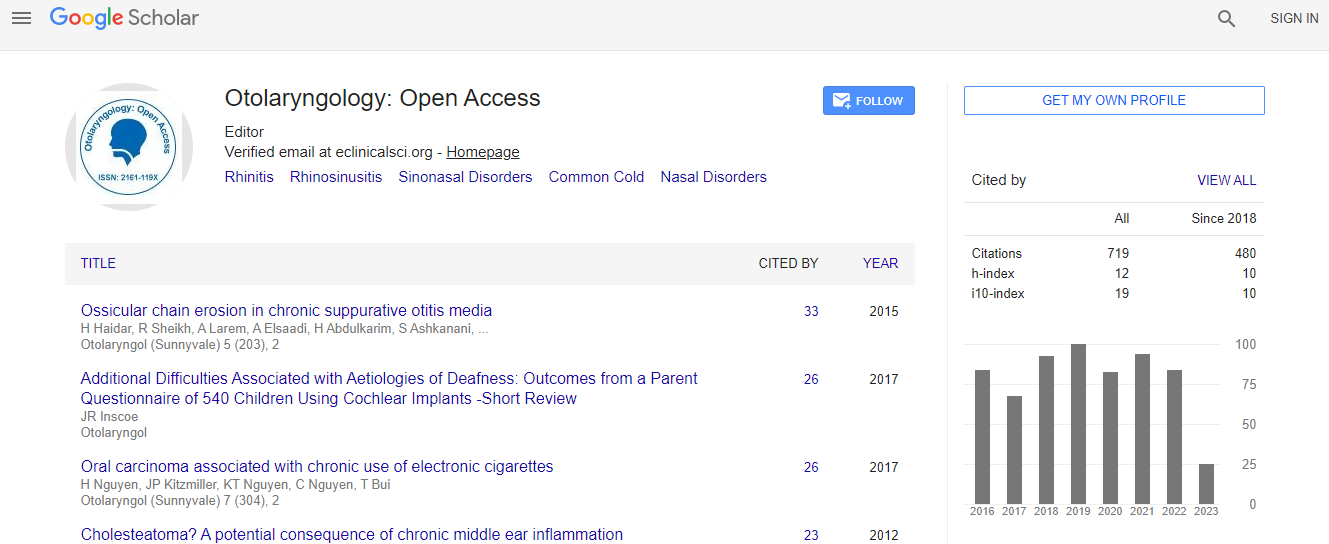Our Group organises 3000+ Global Conferenceseries Events every year across USA, Europe & Asia with support from 1000 more scientific Societies and Publishes 700+ Open Access Journals which contains over 50000 eminent personalities, reputed scientists as editorial board members.
Open Access Journals gaining more Readers and Citations
700 Journals and 15,000,000 Readers Each Journal is getting 25,000+ Readers
Google Scholar citation report
Citations : 925
Otolaryngology: Open Access received 925 citations as per Google Scholar report
Otolaryngology: Open Access peer review process verified at publons
Indexed In
- Index Copernicus
- Google Scholar
- Sherpa Romeo
- Open J Gate
- Genamics JournalSeek
- RefSeek
- Hamdard University
- EBSCO A-Z
- OCLC- WorldCat
- Publons
- Geneva Foundation for Medical Education and Research
- ICMJE
Useful Links
Recommended Journals
Related Subjects
Share This Page
Thyroid cytopathology: Its significance in surgical management of thyroid nodule/ malignancies
International Conference and Exhibition on Otolaryngology
Nandini Manoli
ScientificTracks Abstracts: Otolaryngology
Abstract
Thyroid nodules are commonly encountered in clinical practice. More than50% of the world s population harbours atleast one thyroid nodule and the frequency of nodular thyroid disease increases with age. Fine needle aspiration of the thyroid is one of the most commonly practiced areas in non-gynaecologic cytopathology. It was originated in Scandinavia in 1950 and 1960 s. However now it is being used worldwide for its accuracy and advantage in differentiating benign (95%) cases from malignant (5%) cases. The entire current management approach for patients with thyroid disease hinges upon a cytopathologic diagnosis. Even though malignant thyroid disease make up only 5% of lesions, the incidence of encountering cancer after thyroid surgery has risen from 14% to more than 50% in a period of just over 2 decades, which is credited to optimum use of proper FNA technique and better knowledge of the cytomorphological characteristics of thyroid disease. Diagnosis of thyroid nodule requires a multidisciplinary approach which requires a friendly interaction amongst the pathologist, radiologist and medical endocrinologist/head and neck surgeon. As cytomorphological diagnostic expertise is important in proper surgical management of thyroid nodule/thyroid malignancies,a untiring effort of over 40 well known experts from various disciplines from around the globe, the Bethesda system for reporting thyroid cytopathology (TBSRTC) was done in 2010. This system has an probabilistic approach which is well defined, morphologically distinct has a better cytohistologic correlation and inter observed reproducibility for better patient care and surgical management.Biography
Dr. Nandini Manoli is a distinguished professor in Jss medical college, India; she has 17 national and International publications. Her Name included in database of genetic registry in university of London, u.k and area of interest is pathology. She is the Member of British Clinical Cytology Society 2010 and Chair person of Jwalamukhi Devi Award at Cytocon 2010.

 Spanish
Spanish  Chinese
Chinese  Russian
Russian  German
German  French
French  Japanese
Japanese  Portuguese
Portuguese  Hindi
Hindi 
